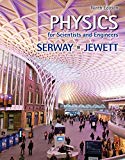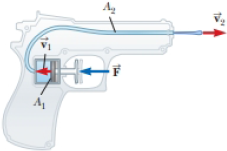
Concept explainers
Review. In a water pistol, a piston drives water through a large tube of area A1 into a smaller tube of area A2 as shown in Figure P14.46. The radius of the large tube is 1.00 cm and that of the small tube is 1.00 mm. The smaller tube is 3.00 cm above the larger tube. (a) If the pistol is fired horizontally at a height of 1.50 m, determine the time interval required for the water to travel from the nozzle to the ground. Neglect air resistance and assume atmospheric pressure is 1.00 atm. (b) If the desired range of the stream is 8.00 m, with what speed v2 must the stream leave the nozzle? (c) At what speed v1 must the plunger be moved to achieve the desired range? (d) What is the pressure at the nozzle? (e) Find the pressure needed in the larger tube. (f) Calculate the force that must be exerted on the trigger to achieve the desired range. (The force that must be exerted is due to pressure over and above atmospheric pressure.)
Figure P14.46

(a)
The time required for the water to travel from the nozzle to the ground.
Answer to Problem 14.78AP
The time required for the water to travel from the nozzle to the ground is
Explanation of Solution
The radius of the large tube is
Formula to calculate the time interval is,
Here,
Substitute
Conclusion:
Therefore, the time required for the water to travel from the nozzle to the ground is
(b)
The speed of the stream to leave the nozzle if the range of the stream is
Answer to Problem 14.78AP
The speed of the stream to leave the nozzle is
Explanation of Solution
Formula to calculate the speed of the stream to leave the nozzle is,
Here,
Substitute
Conclusion:
Therefore, the speed of the stream to leave the nozzle is
(c)
The speed of the plunger is moved to achieve the range of
Answer to Problem 14.78AP
The speed of the plunger is
Explanation of Solution
By continuity equation at the plunger and exit point of the nozzle is,
Here,
Formula to calculate the area of the large tube is,
Here,
Formula to calculate the area of the small tube is,
Here,
Substitute
`
Substitute
Conclusion:
Therefore, the speed of the plunger is
(d)
The pressure at the nozzle.
Answer to Problem 14.78AP
The pressure at the nozzle is
Explanation of Solution
The pressure at the nozzle is equal to the atmospheric pressure.
The atmospheric pressure is equal to the
Conclusion:
Therefore, the pressure at the nozzle is
(e)
The pressure needed in the large tube.
Answer to Problem 14.78AP
The pressure needed in the large tube is
Explanation of Solution
Apply the Bernoulli’s equation at point
Here,
Substitute
Conclusion:
Therefore, the pressure needed in the large tube is
(f)
The force exerted on the trigger to achieve the range of
Answer to Problem 14.78AP
The force exerted on the trigger to achieve the range of
Explanation of Solution
Formula to calculate the force exerted on the trigger is,
Here,
Substitute
Substitute
Conclusion:
Therefore, the force exerted on the trigger to achieve the range of
Want to see more full solutions like this?
Chapter 14 Solutions
Physics for Scientists and Engineers (AP Edition)
Additional Science Textbook Solutions
College Physics: A Strategic Approach (3rd Edition)
Fundamentals Of Thermodynamics
Organic Chemistry
Anatomy & Physiology (6th Edition)
Laboratory Experiments in Microbiology (12th Edition) (What's New in Microbiology)
Genetics: From Genes to Genomes
- Use the following information to answer the next two questions. A laser is directed at a prism made of zircon (n = 1.92) at an incident angle of 35.0°, as shown in the diagram. 3a) Determine the critical angle of zircon. 35.0° 70° 55 55° 3b) Determine the angle of refraction when the laser beam leaves the prism.arrow_forwardNo chatgpt pls will upvotearrow_forwardA beam of alpha-particles of energy 7.3MeV is used.The protons emitted at an angle of zero degree are found to have energy of 9.34MeV.Find the Q-value of this reaction .arrow_forward
- An aluminum rod and a copper rod have the same length of 100cm at 5C. At what temperatures would one of the rods be 0.5 mm longer than the other? Which rod is longer at such temperature?arrow_forwardROTATIONAL DYNAMICS Question 01 A solid circular cylinder and a solid spherical ball of the same mass and radius are rolling together down the same inclined. Calculate the ratio of their kinetic energy. Assume pure rolling motion Question 02 A sphere and cylinder of the same mass and radius start from ret at the same point and more down the same plane inclined at 30° to the horizontal Which body gets the bottom first and what is its acceleration b) What angle of inclination of the plane is needed to give the slower body the same acceleration Question 03 i) Define the angular velocity of a rotating body and give its SI unit A car wheel has its angular velocity changing from 2rads to 30 rads seconds. If the radius of the wheel is 400mm. calculate ii) The angular acceleration iii) The tangential linear acceleration of a point on the rim of the wheel Question 04 in 20arrow_forwardQuestion B3 Consider the following FLRW spacetime: t2 ds² = -dt² + (dx² + dy²+ dz²), t2 where t is a constant. a) State whether this universe is spatially open, closed or flat. [2 marks] b) Determine the Hubble factor H(t), and represent it in a (roughly drawn) plot as a function of time t, starting at t = 0. [3 marks] c) Taking galaxy A to be located at (x, y, z) = (0,0,0), determine the proper distance to galaxy B located at (x, y, z) = (L, 0, 0). Determine the recessional velocity of galaxy B with respect to galaxy A. d) The Friedmann equations are 2 k 8πG а 4πG + a² (p+3p). 3 a 3 [5 marks] Use these equations to determine the energy density p(t) and the pressure p(t) for the FLRW spacetime specified at the top of the page. [5 marks] e) Given the result of question B3.d, state whether the FLRW universe in question is (i) radiation-dominated, (ii) matter-dominated, (iii) cosmological-constant-dominated, or (iv) none of the previous. Justify your answer. f) [5 marks] A conformally…arrow_forward
- SECTION B Answer ONLY TWO questions in Section B [Expect to use one single-sided A4 page for each Section-B sub question.] Question B1 Consider the line element where w is a constant. ds²=-dt²+e2wt dx², a) Determine the components of the metric and of the inverse metric. [2 marks] b) Determine the Christoffel symbols. [See the Appendix of this document.] [10 marks] c) Write down the geodesic equations. [5 marks] d) Show that e2wt it is a constant of geodesic motion. [4 marks] e) Solve the geodesic equations for null geodesics. [4 marks]arrow_forwardPage 2 SECTION A Answer ALL questions in Section A [Expect to use one single-sided A4 page for each Section-A sub question.] Question A1 SPA6308 (2024) Consider Minkowski spacetime in Cartesian coordinates th = (t, x, y, z), such that ds² = dt² + dx² + dy² + dz². (a) Consider the vector with components V" = (1,-1,0,0). Determine V and V. V. (b) Consider now the coordinate system x' (u, v, y, z) such that u =t-x, v=t+x. [2 marks] Write down the line element, the metric, the Christoffel symbols and the Riemann curvature tensor in the new coordinates. [See the Appendix of this document.] [5 marks] (c) Determine V", that is, write the object in question A1.a in the coordinate system x'. Verify explicitly that V. V is invariant under the coordinate transformation. Question A2 [5 marks] Suppose that A, is a covector field, and consider the object Fv=AAμ. (a) Show explicitly that F is a tensor, that is, show that it transforms appropriately under a coordinate transformation. [5 marks] (b)…arrow_forwardHow does boiling point of water decreases as the altitude increases?arrow_forward
 Physics for Scientists and Engineers: Foundations...PhysicsISBN:9781133939146Author:Katz, Debora M.Publisher:Cengage Learning
Physics for Scientists and Engineers: Foundations...PhysicsISBN:9781133939146Author:Katz, Debora M.Publisher:Cengage Learning Physics for Scientists and EngineersPhysicsISBN:9781337553278Author:Raymond A. Serway, John W. JewettPublisher:Cengage Learning
Physics for Scientists and EngineersPhysicsISBN:9781337553278Author:Raymond A. Serway, John W. JewettPublisher:Cengage Learning Physics for Scientists and Engineers with Modern ...PhysicsISBN:9781337553292Author:Raymond A. Serway, John W. JewettPublisher:Cengage Learning
Physics for Scientists and Engineers with Modern ...PhysicsISBN:9781337553292Author:Raymond A. Serway, John W. JewettPublisher:Cengage Learning Principles of Physics: A Calculus-Based TextPhysicsISBN:9781133104261Author:Raymond A. Serway, John W. JewettPublisher:Cengage Learning
Principles of Physics: A Calculus-Based TextPhysicsISBN:9781133104261Author:Raymond A. Serway, John W. JewettPublisher:Cengage Learning College PhysicsPhysicsISBN:9781938168000Author:Paul Peter Urone, Roger HinrichsPublisher:OpenStax College
College PhysicsPhysicsISBN:9781938168000Author:Paul Peter Urone, Roger HinrichsPublisher:OpenStax College College PhysicsPhysicsISBN:9781285737027Author:Raymond A. Serway, Chris VuillePublisher:Cengage Learning
College PhysicsPhysicsISBN:9781285737027Author:Raymond A. Serway, Chris VuillePublisher:Cengage Learning





